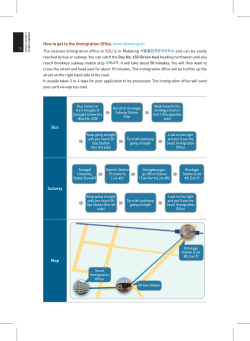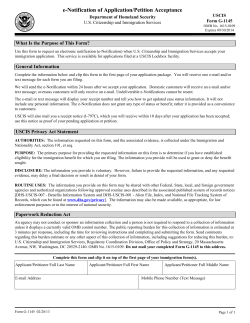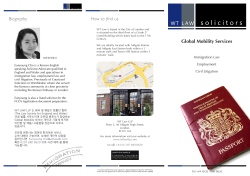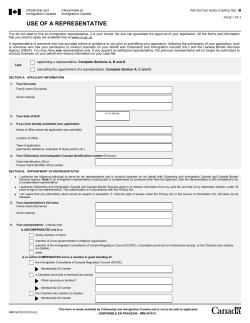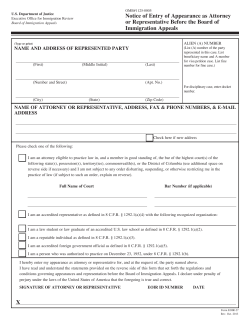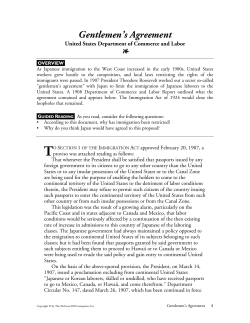
How to fix the U.S. immigration system, and ensure it stays fixed.
How to fix the U.S. immigration system, and ensure it stays fixed. Someone: First Lastname By Tamar Jacoby 66 Americas Quarterly s u m m e r 2008 a m e r i c a s q u a r t e r ly . o r g Not Another Generation by Tamar Jacoby Someone: First Lastname T he 2007 defeat of comprehensive immigration reform was one of the bitterest and bloodiest routs in recent memory in the U.S. Senate. The President and powerful lawmakers from both parties had invested their reputations in an overhaul. More than a million people had marched in the streets in support. Some 85 percent of the public had an opinion on the legislation. And no one on either side questioned that the immigration system desperately needed an overhaul. Yet after the vote, Congress dropped the issue as if it were radioactive. The only problem: the immigration system is still broken. The U.S.-Mexico border is still all but unenforceable. More than 12 million unauthorized immigrants—a population the size of Pennsylvania—still live on the wrong side of the law. Vast mounds of produce still rot in the fields every year due to a lack of workers. And hundreds of would-be laborers still die in the desert trying to enter the country. The only beneficiaries of the broken system are the smugglers who prey on these migrants. Just when Congress will get back to the issue is anybody’s guess. But it’s not too soon to start thinking about policy. And in some ways, the defeat of 2007 wipes the slate clean, inviting a fresh look at old problems. The place to start is by clarifying what doesn’t work. Warning: there may not The U.S. immigration system is a vast, complex machine be a slot for you at the with hundreds if not thousands of moving parts. And end of the line. while public attention is focused on a single conunA Mexican worker drum—what to do about the unauthorized immigrants lines up outside a U.S. already in the country—in the long run, that is far from Consulate in Mexico the most important question. before his visa interview. Why? Because these 12 million unauthorized immigrants a m e r i c a s q u a r t e r ly . o r g summer 2008 Americas Quarterly 67 Immigration Foreign workers immigrants are the product of failures elsewhere in the system. The first, most obvious failure is enforcement. For most of our history, the southwestern border was all but unmonitored, and people crossed freely in both directions. There were no immigration quotas for Latin America until 1965. Even when we began to get serious about the border, in 1993, we put few resources where it really counts: in the workplace. Not until 1986 was it illegal for employers to hire unauthorized workers. And in 2004—a year when there were thought to be seven million unauthorized immigrants working in the U.S.—the immigration service fined exactly three employers. But enforcement isn’t the only failure, and enforcement alone won’t solve the problem. The core issue is our unrealistic immigration ceilings—annual quotas for who and how many we admit that are completely out of sync with national labor needs. were responsible for half our Filling The Labor Gap W hat are our worker needs, and how do we determine them? One place to look is recent history. For over 15 years, U.S. unemployment has hovered between four percent and six percent—full employment. Yet throughout this period, the U.S. has absorbed and found work for some 1.5 million immigrants, authorized and unauthorized, every year. We could make do without these additional workers, but it would mean much slower economic growth. American workers are aging. American families are having fewer babies. Though our workforce isn’t shrinking yet, its historically robust growth is slowing. But our economy is fundamentally as dynamic as ever and, as long as there are additional workers available, capable of continued expansion. The good news is that millions of foreigners Tamar Jacoby is president of ImmigrationWorks USA, a federation of state-based business coalitions devoted to advancing immigration reform. 68 Americas Quarterly s u m m e r 2008 are ready to fill the gap and help keep the economy vibrant. Immigrants come in search of work, not welfare. A full 94 percent of unauthorized immigrant men have jobs or are looking for them. Immigrant unemployment is comparable to or lower than native-born rates. And newcomers filled roughly half the new jobs created in the U.S. in the past two decades. In other words, foreign workers were responsible for half our economic growth, and in the Southeast and Midwest, for two-thirds of it. Not only that, but newcomers fill jobs and enable growth precisely where the U.S. workforce is weakest. In 1960, half of all American men dropped out of high school and looked for unskilled work; today, fewer than 10 percent do. But many sectors—hospitality, agriculture, construction, among others— still rely on low-skilled workers. And it’s no accident that apprehensions on the border—our best measure of how many migrants are entering the U.S.—now closely mirror the rise and fall of employment in the construction industry. Far from taking work from Americans, immigrants create jobs. Remember, 90 percent of U.S. workers finish high school, while the majority of unskilled foreign workers are high school dropouts. So by and large, the two groups don’t compete, they complement each other. And when the availability of foreign kitchen help enables an entrepreneur to open a new restaurant, for example, that in turn creates work for an American-born chef, an American-born contractor, an American-born banker, farmer, trucker and others. Bottom line: immigrant workers grow the pie for everyone. Immigrants also make the economy more proa m e r i c a s q u a r t e r ly . o r g previous page: Guillermo Arias/ap economic growth. Not Another Generation Tamar Jacoby ductive. Consider high-skilled immigrants—roughly one-fourth of the flow. There isn’t much argument about the newcomers who poured into Silicon Valley in the 1990s: one-third of the science workers and a quarter of the entrepreneurs were foreign-born. Nor do many people doubt the value of the quarter of U.S. doctors who are immigrants, the 40 percent of science PhDs or the 25 percent of U.S. patents issued to newcomers. But unskilled immigrants also increase U.S. productivity—again because of the way they comple- ment American workers. A U.S. brain surgeon has more time for brain surgeries when immigrant workers are cleaning his house and mowing his lawn. Can we predict future labor needs? As in recent decades, there is no fixed number of slots to fill. But the U.S. clearly benefits from the robust flow of immigrants available to fuel our expansion and raise our standard of living. Over the next decade, 75 million baby boomers will retire. Population growth will create demand for two million new housing units each year. The restaurant industry—the nation’s largest western union mmigrants, as laborers and consumers, are a pillar of the U.S. and Latin American. No one is more aware of this than Western Union. One of America’s best-known companies, it derives two-thirds of its revenue from international person-to-person money transfers. That Western Union has long been a leader in promoting immigrant education and integration is less known. One of its largest initiatives, the $50 million “Our World, Our Family,” includes among its programs “family scholarships,” which underwrite skills development, education and financial literacy for immigrants living in the U.S. and their families abroad. Western Union’s newest programs are oriented toward investing in immigrant entrepreneurs. The National Hispanic Business Information Clearinghouse (NHBIC) was founded in August 2007 with a grant from the Western Union Empowerment Fund a m e r i c a s q u a r t e r ly . o r g to provide online support and information to Hispanics starting new businesses. The bilingual site, www.nhbic.org, provides information on gaining access to capital and reaching new markets, as well as skills training. The website delivers targeted advice about navigating local business regulations—a significant hurdle for would-be entrepreneurs. Immigrant entrepreneurs account for 50 to 75 percent of the site’s 200,000 monthly hits. “There’s a Hispanic entrepreneurial movement sweeping the country right now, and we want to sustain that,” says Sal Gomez, NHBIC’s founder. According to NHBIC, the number of U.S. Hispanic-owned businesses is expected to grow from 2.5 million to 3.2 million by 2010. Another Western Union initiative, 4+1, seeks to improve the communities immigrants left behind. The company matches funds provided by migrant hometown associations by Danielle Renwick (HTAs) in the U.S. and the federal, state and local governments in Mexico to support development projects that create jobs in highemigrant areas. “Western Union addresses issues that are important to our constituency such as job creation in sending communities,” explains Mario Hernandez, Western Union’s Director of Public Affairs and director of the initiative. “The long-term solution to the immigration challenge is to create job opportunities in home communities. That’s how we can make migration a choice rather than a necessity.” The 4+1 program has created 4,200 jobs in the state of Zacatecas in the past three years. Among the initiatives currently receiving funding are an eco-tourism park, pig farms, mezcal production plants, and a computer factory. Similar projects will be funded in the states of Michoacan, Veracruz and Guanajuato. summer 2008 Americas Quarterly 69 Immigration private sector employer—is predicted to expand by 15 percent, but the native-born workforce will grow by only 10 percent, and the 16- to 24-year-old workforce that fills most restaurant jobs will not grow at all. Bottom line: conditions are likely to remain ripe for immigrant-driven economic growth that benefits most Americans. The problem is that our immigration system can’t accommodate this growth—at least not legally. Remember, market forces attract some 1.5 million immigrants to the United States every year. But our annual immigration quotas are capped at roughly a million. The consequence of this mismatch: every year, some 400,000 to 500,000 immigrant workers enter the country without papers. To a degree, this is a failure of enforcement, both on the border and in the workplace. But one of the main reasons enforcement is so inadequate is that quotas are so unrealistically out of line with our economic needs. It’s extremely difficult to enforce unrealistic limits. Just think about Prohibition—or a zero-calorie diet. The question for policymakers is how exactly to adjust the diet. This is the most important fix we can make to our immigration system—without it, any reform is doomed to failure. The last major overhaul of the system, the 1986 Immigration Reform and Control Act (IRCA), fell short in part because of Congress’ reluctance to mandate effective enforcement. But even more disastrous was the failure to own up to the reality of U.S. labor needs. Lawmakers falsely believed they could “wean U.S. employers of their dependence” on immigrant workers. There were no new visas in the bill. And employers trying to grow their businesses were put in an impossible position. The challenge now—the challenge at the heart of any immigration overhaul—is to bring quotas into sync with the dynamism of the economy. We need to replace the illegal influx with a legal flow, making enforcement easier and more effective and eliminating the awful choices now facing U.S. employers and immigrant workers alike. Congress Tries and Fails O f all the changes proposed in the immigration bills considered in the Senate in 2006 and 2007, creating more visas for workers was the least popular politically—even less popular than legalizing unauthorized immigrants. Although the need for labor is acute at both ends of the job ladder—we need farmhands just as badly as we need engineers—it was tactically much easier to increase quotas for the high-skilled. And even when the intent was to admit workers permanently, the visas proposed were often temporary or described as temporary—politically, a more palatable option. But the truth is we need both short- and long-term visas. Some of the jobs that need filling are indeed temporary. Think agricultural worker or short-order cook. But other slots, even at the low end of the skill ladder, require a great deal of training: some construction workers need two to three years to become fully productive. There’s an argument for flexibility: workers admitted during a period of rapid economic growth may become superfluous during a downturn—a case for temporary rather than permanent visas. But there’s also an argument for experience: it makes no sense economically to send foreigners home as they become more productive. Migrants, too, and the countries they come from have reasons to want both temporary and permanent visas. Most foreigners initially come to the U.S. to work and make money, and most intend eventually to return home. Many do go home after a while, carrying both capi- In an overhaul of immigration categories, the U.S. would create a new provisional visa. 70 Americas Quarterly s u m m e r 2008 a m e r i c a s q u a r t e r ly . o r g Farm work has become a smaller draw for immigrants, as many now opt for service and skilled work. tal and new skills with them. But the more successful often return to the U.S. for a second work stint. Then after another few years, the cycle repeats, and again the ones who have done the best here—who moved up and like the lifestyle and appreciate our values—often come back, for a third stay. Eventually, after many cycles, these best and brightest (and most assimilated) settle permanently. And it’s a win-win— for the immigrants and for America To Stay Or Not To Stay Miguel Tovar/ap W hat we don’t know is the ideal mix of temporary and permanent. As a rule of thumb, in this realm too, realistic law will work better. If most jobs are permanent and most migrants want to settle in the U.S., a strictly temporary worker program is a recipe for disaster—for more illegality when workers overstay their visas and a disgruntled, churning underclass. But nor does it make sense to give permanent visas to a largely transient labor force—if in fact it is transient. The problem is, we don’t know. Two decades ago, most migrants from Mexico were short-timers. Very few made it through the cyclical winnowing process, and most returned home within a few years. Today, this pattern has changed dramatically, but we don’t know how much. Conventional wisdom points to the fortifying of the border as the main reason for the change. a m e r i c a s q u a r t e r ly . o r g Migrants who have made it to the U.S., this argument goes, don’t want to go home, or don’t dare, for fear that they won’t be able to re-enter at a later date. But increasing numbers of Mexicans are eventually settling in the U.S. for other reasons. Fewer work on farms, more in service jobs and skilled work like construction, where experience and longevity pay. Fewer are concentrated near the border; newcomers now live and work in every region of the United States. Social norms have changed. It’s now common for newcomers to marry and have children who, if they are born here, are automatically U.S. citizens. And there has been a shift in sending countries that is likely to influence settlement patterns in years ahead: Migrants from the poorer nations of Central America are much more inclined than Mexicans to want to stay permanently. The challenge for policymakers is to make the most of this complex reality. What is the proper mix of temporary and permanent? How should we reconcile the conflicting signals we send immigrants about assimilation and transience? Is there a way to encourage those who do well to stay, while also making sure that others leave when their visas expire? The original McCain-Kennedy reform package introduced in the Senate in 2006 solved this problem with a sleight of hand. Though what it proposed were technically temporary worker visas, migrants who received them could apply to stay permanently. And it was anticipated that many if not most of summer 2008 Americas Quarterly 71 Immigration these workers would eventually become permanent U.S. residents. But the underlying idea wasn’t wrong: start with the reality of what people actually do—come to the U.S. temporarily and stay if they succeed—then design policy to regulate and make the most of that pattern. A year after McCain-Kennedy, a blue-ribbon immigration commission sponsored by the Migration Policy Institute picked up on this idea and developed it further. (Full disclosure, I was a member of that task force.) Improvements included a new term: provisional visa. It would last for three years, renewable once. And workers could change to permanent status if they proved they had been continuously employed, were learning English and could pass a background check. The 2007 Senate debate went in a different direction. Under the package proposed that year, “temporary” meant temporary, and the selection of permanent residents was to be made before migrants entered the U.S., using a skill-based “merit” point system. This was unwieldy and unrealistic. Point systems are notoriously bad predictors of what happens when immigrants arrive in a country. Still, a point system could potentially be a useful tool—if used later in the migration process to measure a newcomer’s accomplishment rather than predict potential. How would this work? What if, as part of an overhaul of immigration categories, the U.S. created a new “provisional” visa? OCHSNER health system ew Orleans’ population has changed dramatically in the wake of Hurricane Katrina. Lured by reconstruction jobs, the Hispanic community grew to an estimated 150,000 by 2008, more than double the pre-Katrina population. The Ochsner Health System, Louisiana’s largest health care provider, has been a leader among local businesses in its response to the city’s shifting demographics, and the health care challenges these new residents face. In each of its 33 clinics and seven hospitals statewide, Ochsner has taken steps to adapt its already-existing public outreach to its growing Hispanic constituency, taking into account poor working and housing conditions, lack of cultural familiarity and communication barriers. 72 Americas Quarterly s u m m e r 2008 With interpreters on-site, the group organizes community health expos in local malls, offering free blood pressure screenings, asthma testing and pediatric evaluations, in addition to promoting nutrition and exercise plans. Ochsner served approximately 10,000 people in 2007 alone. They also organize “Hello Health,” a weekly seminar in which Spanish-speaking physicians discuss health concerns ranging from breast cancer to learning disorders with community members. Recognizing the importance of preventive care in this largely uninsured population (57 percent of reconstruction workers are uninsured), Ochsner has forged important relations with local Spanish-language media to disseminate information to Hispanics. The health system sponsors public by Evianna Cruz service announcements on local Spanish radio stations, partners with local station Cox Channel 10 with health specials in Spanish, and are in the initial stages of developing a call-in talk show with the local Telemundo affiliate. Ochsner has also made a concerted effort to overcome language barriers by recruiting Spanish-speaking doctors and nurses and offering Spanish-language classes to all staff members. The classes are catching on: there’s a waiting list for enrollment. Ochsner also offers a Spanish-language maternity program, provides patient handbooks and admission papers in Spanish and employs on-call interpreters. Maintaining a healthy immigrant population translates into maintaining momentum on the reconstruction process. a m e r i c a s q u a r t e r ly . o r g Not Another Generation Tamar Jacoby The number of visas issued each year would depend on the economic climate. The program would start with a realistic estimate of the number of immigrants—authorized plus unauthorized—that had entered the country in recent years. The cap would be designed to float up and down in sync with the ebb and flow of the U.S. job market. Visas would last three years, renewable twice. And when migrants applied to convert from temporary to permanent status, the point system would kick in to assess eligibility, measuring not just skill and language ability, but also advancement and rootedness—assimilation. Workers would get points for years on the job, for moving up the career ladder, for recommendations from employers, for living crime-free and without welfare, for paying taxes, buying a home, obtaining health insurance, avoiding any welfare available through U.S.-citizen wives or children, learning English, serving in the military and knowledge of U.S. history and government, among other criteria. Skill, advanced degrees or a job in a sector with a proven labor shortage would also increase a worker’s score—and the system ought to be designed to attract skilled newcomers. But they too should be given incentives to adopt our way of life and embrace our ideals. Under a new system centered around provisional work visas, family-based permanent visas—now two-thirds of the total—would probably be reduced. But a well-settled family that helped a migrant put down roots would yield significant points under the new numeric scheme. The result would be a system based on reality, but tempered by our national interest and values. The driving rationale would be economic, but not at the cost of national cohesion. The new plan would build on the natural winnowing process that currently sorts transients from settlers, but would add incentives for both circularity and citizenship—for going home when a visa expired and for staying to become a fully integrated member of society. It would benefit not just the Indian engineer who arrived with perfect English, but also the Mexican busboy who worked hard and rose to be the manager of the coffee shop, learning English at night and saving money to buy a home for his family. The goal: a m e r i c a s q u a r t e r ly . o r g a win-win-win for immigrants, the United States and the sending countries they come from. What About Those Already Here? H ow would the plan affect the 12 million unauthorized immigrants already in the country? Directly, not at all. We need an answer for that population—for our own sake as much as theirs. We can’t hope to restore the rule of law or know reliably who is in the country until we resolve their situation. A fix for them would augment tax revenues and help create a level playing field for American workers. It would also put an end to the travesty of our values created by millions of people living permanently among us but on the margins of society. Whatever answer we come up with must be tough but fair, recognizing that these workers broke the law, but broke it with our encouragement. Given the tangled history, this group can’t just be thrown in with new, incoming migrants. Yet there’s no reason why the point system, with its premium on assimilation, can’t apply to this 12 million too. Indeed, unless we think we are going to send them home— an impossible goal—it’s in our interest to encourage their assimilation. But what’s most important in the long run is not the workers already here—it’s the future. We must avoid repeating the mistakes of the past—must avoid another generation and then another of migrant workers doomed to live outside the system and on the wrong side of the law. This is our fault as much as theirs—our fault for failing to own up to our labor needs and create a system that can accommodate them legally. It’s cruel and unjust for the immigrants, but it’s arguably worse for us—for the rule of law, our security, our values. Surely, as Americans, citizens of a country known for its pragmatism, we can bring ourselves to recognize the reality of immigration and craft a policy to harness its power rather than pretend it doesn’t exist. Not just our economy but our character as a nation is at stake. summer 2008 Americas Quarterly 73
© Copyright 2025






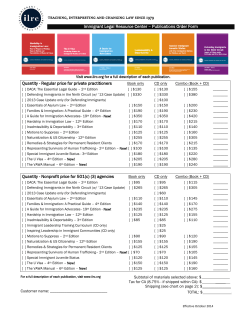

![Chapter 3 Homework Review Questions Lesson 3.1 [pp. 78 85]](http://cdn1.abcdocz.com/store/data/000248451_1-668327adcad67c478c93f46227ffd100-250x500.png)
